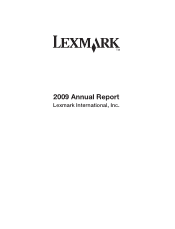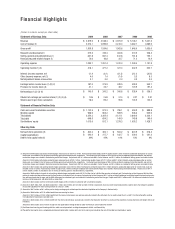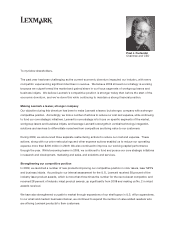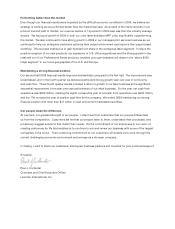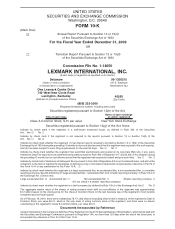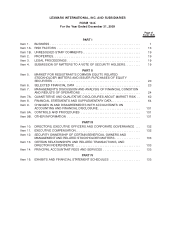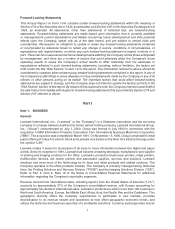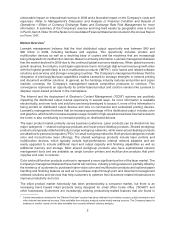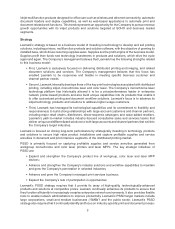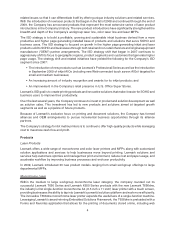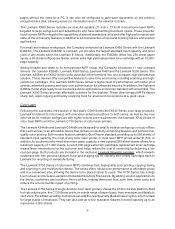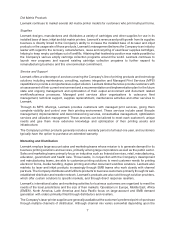Lexmark 2009 Annual Report Download - page 8
Download and view the complete annual report
Please find page 8 of the 2009 Lexmark annual report below. You can navigate through the pages in the report by either clicking on the pages listed below, or by using the keyword search tool below to find specific information within the annual report.
unfavorable impact on international revenue in 2009 and a favorable impact on the Company’s costs and
expenses. Refer to Management’s Discussion and Analysis of Financial Condition and Results of
Operations — Effect of Currency Exchange Rates and Exchange Rate Risk Management for more
information. A summary of the Company’s revenue and long-lived assets by geographic area is found
in Part II, Item 8, Note 18 of the Notes to Consolidated Financial Statements included in this Annual Report
on Form 10-K.
Market Overview
1
Lexmark management believes that the total distributed output opportunity was between $80 and
$90 billion in 2009, including hardware and supplies. This opportunity includes printers and
multifunction devices as well as a declining base of copiers and fax machines that are increasingly
being integrated into multifunction devices. Based on industry information, Lexmark management believes
that the market declined in 2009 due to the continued global economic weakness. When global economic
growth resumes, the industry could again experience low to mid single digit annual revenue growth rates
with the highest growth likely to be in multifunction products (“MFPs”), color lasers and related software
solutions and services and stronger emerging countries. The Company’s management believes that the
integration of print/copy/fax/scan capabilities enables Lexmark to leverage strengths in network printing
and document workflow solutions. In general, as the hardcopy industry matures and printer and copier
markets converge, the Company’s management expects competitive pressures to continue. This
convergence represents an opportunity for printer-based product and solution vendors like Lexmark to
displace copier-based products in the marketplace.
The Internet and the deployment of Electronic Content Management (“ECM”) systems are positively
impacting the distributed output market opportunity in several ways. As more information is available
electronically, and new tools and solutions are being developed to access it, more of this information is
being printed on distributed output devices and less on commercial and centralized printing devices.
Lexmark’s management believes that an increasing percentage of this distributed output includes color
and graphics, which tend to increase supplies usage. Growth in high-speed and wireless Internet access to
the home is also contributing to increased printing on distributed devices.
The laser product market primarily serves business customers. Laser products can be divided into two
major categories — shared workgroup products and lower-priced desktop products. Shared workgroup
products are typically attached directly to large workgroup networks, while lower-priced desktop products
are attached to personal computers (“PCs”) or small workgroup networks. Both product categories include
color and monochrome laser offerings. The shared workgroup products include laser printers and
multifunction devices, which typically include high-performance internal network adapters and are
easily upgraded to include additional input and output capacity and finishing capabilities as well as
additional memory and storage. Most shared workgroup products also have sophisticated network
management tools and are available as single function printers and multifunction products that print/
copy/fax and scan to network.
Color and multifunction products continue to represent a more significant portion of the laser market. The
Company’s management believes these trends will continue. Industry pricing pressure is partially offset by
the tendency of customers to purchase higher value color and multifunction products and optional paper
handling and finishing features as well as to purchase output through print and document management
software solutions and services that help customers to optimize their document-related infrastructure to
improve productivity and cost.
The inkjet product market historically has been predominantly a consumer market, but there is an
increasing trend toward inkjet products being designed for small office home office (“SOHO”) and
other businesses. Customers are increasingly seeking productivity-related features that are found in
2
1
Certain information contained in the “Market Overview” section has been obtained from industry sources, public information and
other internal and external sources. Data available from industry analysts varies widely among sources. The Company bases its
analysis of market trends on the data available from several different industry analysts.

